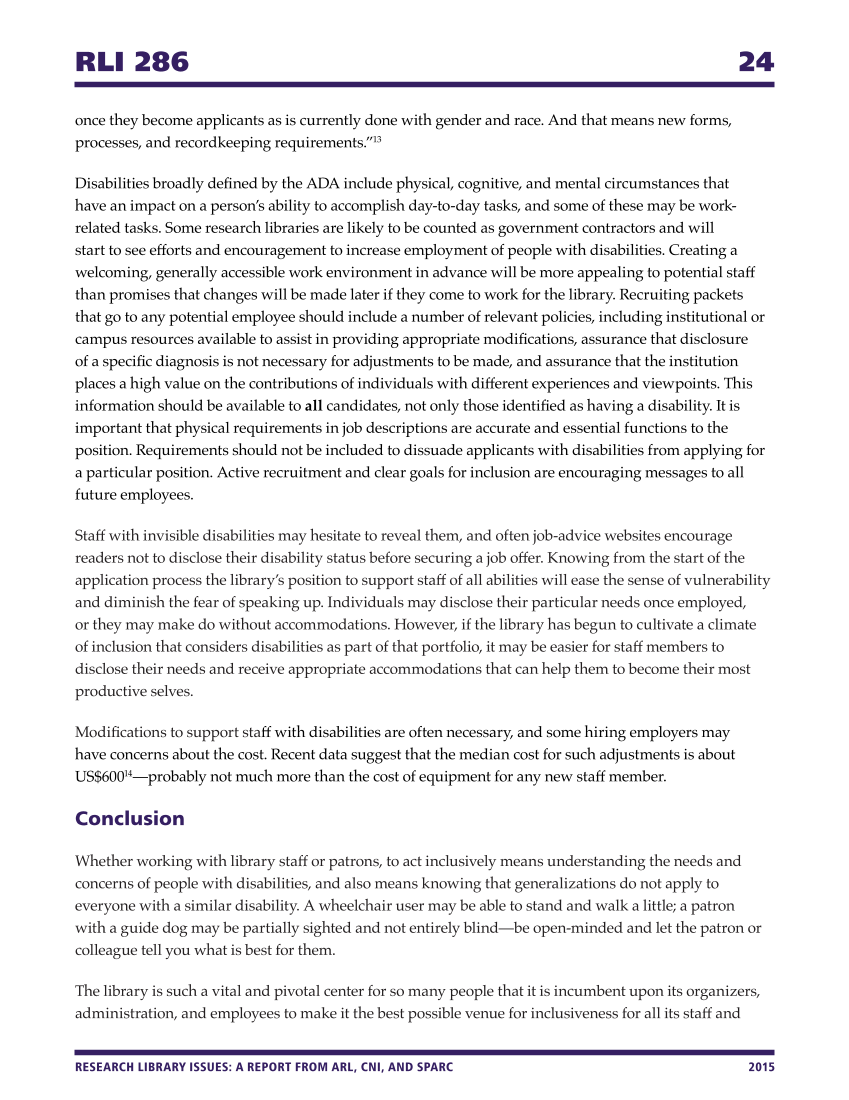RLI 286 24 RESEARCH LIBRARY ISSUES: A REPORT FROM ARL, CNI, AND SPARC 2015 once they become applicants as is currently done with gender and race. And that means new forms, processes, and recordkeeping requirements.”13 Disabilities broadly defined by the ADA include physical, cognitive, and mental circumstances that have an impact on a person’s ability to accomplish day-to-day tasks, and some of these may be work- related tasks. Some research libraries are likely to be counted as government contractors and will start to see efforts and encouragement to increase employment of people with disabilities. Creating a welcoming, generally accessible work environment in advance will be more appealing to potential staff than promises that changes will be made later if they come to work for the library. Recruiting packets that go to any potential employee should include a number of relevant policies, including institutional or campus resources available to assist in providing appropriate modifications, assurance that disclosure of a specific diagnosis is not necessary for adjustments to be made, and assurance that the institution places a high value on the contributions of individuals with different experiences and viewpoints. This information should be available to all candidates, not only those identified as having a disability. It is important that physical requirements in job descriptions are accurate and essential functions to the position. Requirements should not be included to dissuade applicants with disabilities from applying for a particular position. Active recruitment and clear goals for inclusion are encouraging messages to all future employees. Staff with invisible disabilities may hesitate to reveal them, and often job-advice websites encourage readers not to disclose their disability status before securing a job offer. Knowing from the start of the application process the library’s position to support staff of all abilities will ease the sense of vulnerability and diminish the fear of speaking up. Individuals may disclose their particular needs once employed, or they may make do without accommodations. However, if the library has begun to cultivate a climate of inclusion that considers disabilities as part of that portfolio, it may be easier for staff members to disclose their needs and receive appropriate accommodations that can help them to become their most productive selves. Modifications to support staff with disabilities are often necessary, and some hiring employers may have concerns about the cost. Recent data suggest that the median cost for such adjustments is about US$60014—probably not much more than the cost of equipment for any new staff member. Conclusion Whether working with library staff or patrons, to act inclusively means understanding the needs and concerns of people with disabilities, and also means knowing that generalizations do not apply to everyone with a similar disability. A wheelchair user may be able to stand and walk a little a patron with a guide dog may be partially sighted and not entirely blind—be open-minded and let the patron or colleague tell you what is best for them. The library is such a vital and pivotal center for so many people that it is incumbent upon its organizers, administration, and employees to make it the best possible venue for inclusiveness for all its staff and



























